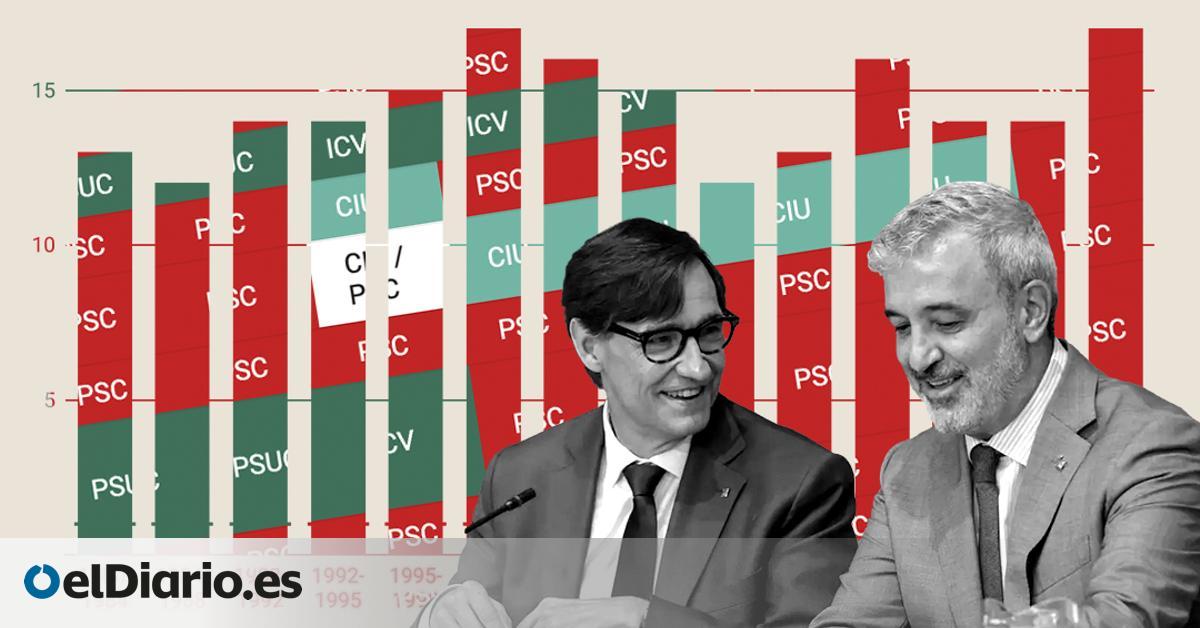
There are few demonstrations of power in Catalonia like governing on both sides of the Plaça Sant Jaume. Jordi Pujol, remembered for extending the influence of CiU to the borders of the community, never managed to do so. He was prevented from doing so by the mayor of Barcelona, Pasqual Maragall, the same person who would achieve that milestone for the PSC, governing in the Palau de la Generalitat and Barcelona City Hall at the same time, something that José Montilla maintained and that the Convergent Artur Mas was also able to match for three years.
The image of the control of the two most powerful administrations in Catalonia was repeated on August 23, in this new political cycle after the procés in which the socialists Salvador Illa and Jaume Collboni greeted each other as president of the Government and mayor of Barcelona, respectively. But the domains of the PSC, which reaches quotas of power almost unprecedented in its history, go further: it governs in the majority of the most populated cities and is in the government of three of the four provincial councils.
Although in total figures he has fewer deputies and fewer mayoralties than in his golden age, before the outbreak of the economic crisis (2007-2010), now the difference is that he does not have to share the Generalitat with other political forces, as happened with the tripartite governments with ERC and ICV. In addition, Illa aspires to greater influence over Pedro Sánchez’s Executive by governing the autonomous community in which the current PSOE places its hopes for the future.
The PSC’s visible share in Moncloa is one minister, Jordi Hereu (of Industry and Tourism), but at the same time the names of the party stand out in the large state companies: Maurici Lucena in Aena, Raül Blanco in Renfe, Toni Llardén in Enagás and Marc Murtra in Indra.
A solo government for the first time
At the head of the Government, a machine that manages 40,000 million euros annually from its –now– 17 ministries, not even this almighty Illa’s PSC has had an easy time recruiting senior officials in the Catalan administration. It is estimated that there are around 500 of them, including secretaries and general directors, advisors and managers of public companies. These include Ports of the Generalitat, Infrastructures, the Ter-Llobregat water management body and the housing body, the Catalan Land Institute (Incasòl).
Illa has chosen for the under-government some of the deputies he trusts, such as Jordi Terrades, Pol Gibert or Raül Moreno, general secretaries of Territory and Enterprise and Employment, respectively. He has also made use of municipal positions: three are the mayors who have moved to the Generalitat: Juli Fernández (Palafrugell), Xavier Amor (Pineda de Mar) and Eduard Rivas (Esparraguera), without counting Nuria Parlon, former mayor of Santa Coloma de Gramenet and now Minister of the Interior.
60% of Catalans in PSC municipalities
As for municipal power, a simple look at the mayoralties could lead to the conclusion that the PSC is light years away from its best electoral harvests. It currently has 127 mayors, half of the 270 it won in the local elections of 2007. However, the main cities are once again its own. 16 of the 25 most populated municipalities have a socialist mayor, while in its best times there were 20.
The situation is even clearer in terms of governed population: 60% of Catalans live in municipalities governed by the PSC. The next party in local power, Junts, which boasts of holding more mayoralties than anyone else (332), rules in municipalities that actually account for 22% of the population.
60% of Catalans live in cities governed by the PSC
Evolution of the percentage of municipalities governed by each party in Catalonia, and of the population according to the colour of the government of the city where they reside
Fuente: Municat
Further away from the media spotlight, in the provincial councils, which are essential for local financing, the PSC’s domains also extend. It holds the presidency of the Barcelona council, and at the same time is a member of the executives led by ERC in Tarragona and Lleida.
Control over large budgets
Of the various formulas for measuring political power, perhaps none is better than the budget to understand the scope of what the PSC has achieved. To the 40 billion euros managed by the Generalitat, we must add, in this order, the 3.8 billion euros of the Barcelona City Council; the 1.2 billion of the Barcelona Provincial Council; the 1.2 billion of the Barcelona Metropolitan Area (AMB), the supra-municipal body also presided by Jaume Collboni. The first accounts by volume that are not managed by a socialist are those of the Terrassa City Council, from the independent Jordi Ballartamounting to around 300 million.
One chapter where the PSC has not recovered the strength of its best moments, although it is not far away, is in the legislature. In the Parliament, Illa won with 42 deputies, a figure lower than the record of Pasqual Maragall in 1999, with 52. But it is still the current second best record of the PSC in the Catalan Chamber, tied with the 42 seats that Maragall also achieved in 2003.
And something similar can be seen in Congress, although with a more moderate rise. The 19 seats obtained in the summer of 2023 by the candidate Meritxell Batet, who has now retired from the political front line, mean leaving behind the setback that led them to obtain only 7 deputies in 2016, curiously Batet also as number 1. However, the most successful general elections for the PSC continue to be those of Carmen Chacón in 2008: 25 seats.
Source: www.eldiario.es

